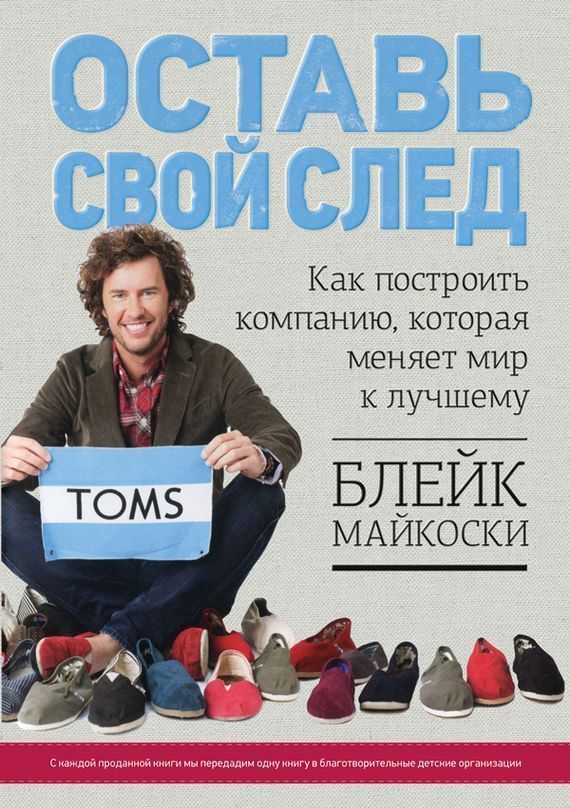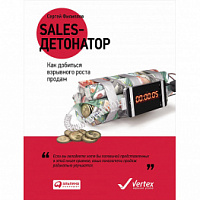
What will help you raise your business to new heights

Blake Maikoski created his shoe company TOMS virtually from scratch. The company is famous not only for its shoes, but also for the fact that for each pair sold it gives a pair to children for free. At the same time, TOMS is a profitable company. In his book, Blake talks about the history of creating a successful brand and a true business philosophy.

B. Maykoski. “Leave your mark. How to build a company that changes the world for the better. " Mann, Ivanov and Ferber Publishing House, Moscow, 2012
The power of stories
Stories are the simplest and purest form of communication. The most powerful values and ideas of our civilization awakening us are embedded in stories ranging from Homer, whose epic poems became unifying for the national spirit of the ancient Greeks, and Virgil, whose poems served the same for the Romans. Such are the parables of Jesus told to his disciples. Apparently, we are genetically predisposed to transfer our ideas in the form of stories, enjoy them and learn from them. According to a recognized storyteller and writer Kendall Haven, author of Super Simple Storytelling: “Human thinking perceives stories and their architecture as the main roadmap for understanding, comprehending, assimilating and planning life - along with countless examples of experiences and descriptions that we encounter on his way".
Intelligent, future-oriented companies use this centuries-old impulse in modern ways, telling stories that people can discuss on Facebook and even watch on YouTube. As soon as you manage to create a memorable story about yourself, about your mission, your success ceases to depend directly on your experience, number of academic degrees and even your knowledge. A good story blurs boundaries, breaks down barriers, and opens doors. This is the key not only to starting a business, but also to your personality, to clarifying your priorities. History evokes emotions, and thanks to emotions, bonds are strengthened. That's why the way that companies tell customers about themselves is changing. They simply can no longer rely on straightforward advertising campaigns like those captured on the Mad Men television series Mad Men.
Avalanche of information
Media is becoming more fragmented, and consumer attention is being scattered. People stopped listening to the same radio station or watching one television channel from week to week. They follow a carefully filtered Twitter feed, create their own blogs, comment on other people's posts, switch from one of five hundred television channels to another, watch streaming video on their laptops using the Hulu service, click on YouTube links, read e-books and take notes on iPad . Due to the fact that a lot of opinions, a lot of positive and negative reviews about any product are opened with the click of a button, making a purchase decision is not simpler, but much more difficult. And until the information attracts you emotionally, most of it is likely to be forgotten.
Business consultant Annette Simmons explains it this way: “Facts remain neutral as long as people do not supplement their own semantic load. And they make decisions based on what these facts mean to them personally, and not on the facts themselves. Interpretation depends on the current history of a person ... bare facts will convince few. People do not need only new facts - they need a new story. ”
Even an avalanche of facts is weaker in effect than a simple, well-told story — and this is supported by scientific evidence. In 2009, researchers at Carnegie Mellon University compared how a person’s behavior changes depending on whether they share abstract facts or a specific story with him. The team offered students five dollars for a review of various gadgets. At the same time, students did not know that the essence of the matter was not in the articles. They studied their behavior after they were paid for the work done. After writing an article, each student received five one-dollar bills and a letter aleatherg him to donate part of his earnings to the famous international fund Save the Children. Two versions of the letter were compiled. One entirely consisted of facts about food shortages in Malawi and statistics showing the relationship between rare rains and chronic crop failures. In the second, a story was told about a desperately poor seven-year-old Malawian girl named Rokia. Students who received a letter with statistics donated an average of 1,14 dollars. Students who read the story of Rocky donated 2,38 dollars. Researchers then gave the third group of students both letters. This group donated an average of one dollar less than those who read only the story of Rocky. The facts are important, but the story is very important. Sometimes misrepresented facts can blur the impression of a story told and weaken its impact.
The people who share the TOMS story are not just our customers, they are our support group. TOMS customers like to say that they support our mission, and not just chat about the fact that they bought the shoes of some ordinary company. They support the product and history in a way that an ordinary customer will never do. The support group will always replay any regular customer in all respects.
However, the search for supporters begins with a story worth supporting. Conscious capitalism is not limited to making money (although, of course, it does this). Its essence is to create a successful business that brings together supporters around an important topic for them and for the business.. Your customers choose your product for quite ordinary reasons: it works better, looks more fashionable, sells at a competitive price, offers innovation. But in addition, as believers, they believe in what you are doing, they accept your story because it is connected with something real, meaningful, and they want to become part of this present. That is why meeting with that woman at the airport was so important to me. Every company needs supporters like her.
Your story can not only find the path to the main client, but also attract potential partners to you who want to be included in something more important than just the process of buying and selling. Each of us belongs to a community related to our hometown, university, college or favorite sports team. By understanding which communities you belong to, you can identify your target audience and find a story. A story that helps you start a business, protect your dream business, or achieve another goal you are striving for.
Now think about how to find your story. Almost everyone has a passion for something, but sometimes it is difficult to determine the direction of this desire. It is very easy to drown out the call of this passion, to lose touch with it - we are always distracted by everyday life; and just in the conditions of constant fuss, chatter and monotonous affairs, nobody dreams of our dreams. That is why it is extremely important at the first opportunity to clearly tell yourself about it. And when you realize what you are striving for, you will find your story. If you are not sure what your passion is, perhaps three questions will help you, which sometimes I ask:
- If you didn't have to worry about money, what would you do?
- What kind of work would you do?
- What purpose would you devote yourself to?
By answering them, you will understand what your passion is. Give yourself time: it is possible that you need to think carefully to give accurate answers. But as soon as you understand what exactly you are passionately striving for, you will lay the foundation for your story and the beginning of your project. The more you love what you do, the more likely you are to improve and achieve success. If you make your passionate desire the organizing center of life, then you will be able to turn it into a story, and then make something bigger out of history - something that really matters and will allow you to leave your mark.
Tell your story to the world.
As soon as you find a story and start your project - be it business, charity, or even looking for a new job - the question arises: how to convey the story to everyone? The most important thing - promise yourself to tell her whenever possible. This is not a random part of your business, but the main area on which you need to focus. Otherwise, you simply will not take the necessary time to perfect your story and be creative in disseminating it. Every day at TOMS we make every effort to let people know our story - the story that we make great shoes and, having sold one pair, give the other to a child in need. For example, we organized a special unit - TOMS Campus Department - to support schoolchildren and students who want to join our movement. We quickly take on the good ideas of our supporters and use them no less willingly than those that are born in our brainstorming sessions. For example, in 2008, students from the TOMS campus at Pepperdine University began walking around the university barefoot. They wanted to feel what it was like to not have shoes, and to draw attention to the problem. We thought: awesome idea! And soon TOMS launched a program called “One Day without Shoes” (ODWS). Every year in April, we ask our customers and like-minded people to go barefoot one day. In 2010, more than 250 thousands of people around the world participated in ODWS events, with 1600 of them gathering thanks to our site. We do not stop thinking of ways to tell the world our story, because we ourselves believe in it, in its importance. People feel the authenticity of a story and, as a rule, are able to distinguish it from a story invented to make money. And not only people from outside, but also employees and managers of the organization or project. However, if you sincerely and genuinely love your story, you will love and share it with everyone.
Here are some tips on how you can spread your story.
- Arrange test drive stories. Your friends and colleagues know you best. Start with them. They will help you find weaknesses in history, remove what seems unnatural, and hone working moments. You will easily notice what confuses them, it seems boring, and what causes a response and encourages action.
- Share your story with anyone you can. Now that your story has been polished, make a list of the groups you are associated with that will help you take the next step. Include social network contacts (for example, “friends” on Facebook or followers on Twitter), representatives of your school’s alumni association. Do not forget those with whom you do sports on weekends, and those who go with you to yoga, parishioners of their church, and so on. All of these are your communities, which are already not indifferent (albeit sometimes in general terms) to what you do in your life. But do not stop there. Tell a story whenever someone asks, “So what are you doing?” I, for example, enjoy talking on ski lifts, on the subway, on airplanes, at parties, trade shows, and on business development meetings. Let your main passion manifest itself freely, whenever possible. Whether your story gets a lively response or hangs in silence will be immediately noticeable. Therefore, each time you not only share it, but also grope for new ways to improve it.
- Find partners for the story. Stories are never isolated. If your story resonates with someone else, find a way to combine them. If your story is richer, more interesting than your product, services (or even you yourself), then other people and companies will want to cast a glimpse into their activities. Achieve a halo effect by incorporating your story into your own. Here are some examples of this collaboration with TOMS. Vogue publisher gives TOMS shoes to people on their special contacts list (most of them have never heard of TOMS before). The Ralph Lauren brand created a special design for the limited edition TOMS shoe line and sold it at Rugby stores throughout the country. Theory, a popular clothing brand, presented TOMS shoes on its 18-meter display window in the main Manhattan chain store and during the design of other stores. Under the word “DARIM” written in huge letters, the history of TOMS was given. All this was done for a simple purpose: Theory shared her favorite story - our story - with her customers.
- Take the story online seriously. If someone wants to hire you, consult with you, join your business (or even go on a date with you), he will go online and look for information about you. Your Facebook page, your data on Tumblr or Flickr can be found quickly enough, and if they are not interesting and do not allow you to feel the connection with your history, then not everyone will want to deal with you. Of course, the solution is not to cleanse the Internet of its presence. On the contrary, you are interested in finding prospective partners, employers, colleagues (or even potential girlfriends) - and the online image provides an excellent opportunity to strengthen the impression that you make in person. The key is to have your personality on the Web reflect your real identity and match the essence of your story. And do not post anything on the Internet that you would not want to show to others. Google gives all the search results, it doesn’t matter whether they confuse you or not.
- Find outgoing people who are passionate about your story. In every niche there are people whom Malcolm Gladwell in his book "Tipping Point" aptly called "unifiers" - sociable people who are the core of an extensive network of connections. Make sure that your story becomes available to those who are able to spread it around the world. Tell your story to the silent person - maybe you will get another supporter. Tell her outgoing lover to talk - and your story will fly apart.
- Choose recipients. It’s very important to know the audience you are reaching out to. In essence, your story is a story about a specific idea, product, or experience that you offer. You cannot satisfy absolutely everyone, while maintaining integrity and self-confidence. Make sure that your story appeals specifically to those whom you want to see among your supporters, and that it is related to your fundamental strength.
| Please rate the article |
Materials on the topic

How to increase sales of shoes and accessories?

Sales detonator. How to achieve explosive sales growth

The maximum concentration. How to maintain efficiency in the era of clip thinking

100 business technology. How to take a company to a new level

Management Formula. A practical guide for a novice leader.
Popular
 We are ready for active development in the Russian market
Friedrich Naumann, CEO of the Tamaris brand, told Shoes Report about the company’s ambitious plans, business development in Russia and expansion of the retail network, and also shared details about new collections and launches.
We are ready for active development in the Russian market
Friedrich Naumann, CEO of the Tamaris brand, told Shoes Report about the company’s ambitious plans, business development in Russia and expansion of the retail network, and also shared details about new collections and launches.
 Coach turned to Big Data analysis and won the interest of a young audience
American handbag brand Coach has planned the success of its Tabby model among a younger audience, Generation Z, by turning to big data analysis, abandoning traditional and analogue tools, such as human intuition or the ability of any executive to sense “which way the wind will blow,” writes B.O.F.
Coach turned to Big Data analysis and won the interest of a young audience
American handbag brand Coach has planned the success of its Tabby model among a younger audience, Generation Z, by turning to big data analysis, abandoning traditional and analogue tools, such as human intuition or the ability of any executive to sense “which way the wind will blow,” writes B.O.F.
 IDOL updates the concept
The IDOL brand, part of the Melon Fashion Group portfolio, opened the first flagship in an updated concept in the Aviapark shopping center in Moscow.
IDOL updates the concept
The IDOL brand, part of the Melon Fashion Group portfolio, opened the first flagship in an updated concept in the Aviapark shopping center in Moscow.
 Louis Vuitton opens a new factory in Italy
Louis Vuitton has opened its second shoe factory in Italy. After opening the first one in Fiesso d'Artico in Veneto, the LVMH flagship brand has just opened a new production site dedicated to this category of footwear in the industrial zone of Civitano in the Marche region. There is also another brand production facility in Tuscany, where bags and leather accessories are produced, writes fr.fashionnetwork.com.
Louis Vuitton opens a new factory in Italy
Louis Vuitton has opened its second shoe factory in Italy. After opening the first one in Fiesso d'Artico in Veneto, the LVMH flagship brand has just opened a new production site dedicated to this category of footwear in the industrial zone of Civitano in the Marche region. There is also another brand production facility in Tuscany, where bags and leather accessories are produced, writes fr.fashionnetwork.com.
 The Euro Shoes@CAF exhibition will be held in Almaty
From March 11 to 13, the Euro Shoes@CAF (Central Asia Fashion) exhibition will be held in Almaty at the Atakent exhibition complex. The exhibition, which is the largest international event in the fashion industry in Central Asia, will present collections of clothing, shoes and accessories.
The Euro Shoes@CAF exhibition will be held in Almaty
From March 11 to 13, the Euro Shoes@CAF (Central Asia Fashion) exhibition will be held in Almaty at the Atakent exhibition complex. The exhibition, which is the largest international event in the fashion industry in Central Asia, will present collections of clothing, shoes and accessories.
 VAGA SHOES is a new participant in the Euro Shoes premiere collection
The Russian women's shoe factory VAGA SHOES will take part for the first time in the international exhibition of footwear and accessories Euro Shoes premiere collection in Moscow.
VAGA SHOES is a new participant in the Euro Shoes premiere collection
The Russian women's shoe factory VAGA SHOES will take part for the first time in the international exhibition of footwear and accessories Euro Shoes premiere collection in Moscow.
 Euro Shoes will start operating on February 19 in Moscow!
The winter session of the international exhibition of footwear and accessories Euro Shoes premiere collection will be held in Moscow at the Expocenter from February 19 to 22. The organizers promise the presence of all the main participants at the exhibition, as well as new names from Europe, Asia and Russia.
Euro Shoes will start operating on February 19 in Moscow!
The winter session of the international exhibition of footwear and accessories Euro Shoes premiere collection will be held in Moscow at the Expocenter from February 19 to 22. The organizers promise the presence of all the main participants at the exhibition, as well as new names from Europe, Asia and Russia.
 American buyers couldn't buy Birkin bags and sued Hermès
French fashion house Hermès is facing a lawsuit in California from two customers who were unable to purchase exclusive Birkin bags. The fashion house is accused of unfair commercial practices.
American buyers couldn't buy Birkin bags and sued Hermès
French fashion house Hermès is facing a lawsuit in California from two customers who were unable to purchase exclusive Birkin bags. The fashion house is accused of unfair commercial practices.
 John Galliano and Christian Louboutin created the Tabi collection for Maison Margiela
Maison Margiela creative director John Galliano and French shoe designer Christian Louboutin released a shoe collaboration that was included in the Maison Margiela Artisanal spring 2024 couture collection. The design duo created six versions of the Tabi shoe. All shoe models in the collection have a split toe - a characteristic touch of the signature Tabi shoe model of the Maison Margiela brand. And Christian Louboutin gave the shoe its signature red sole.
John Galliano and Christian Louboutin created the Tabi collection for Maison Margiela
Maison Margiela creative director John Galliano and French shoe designer Christian Louboutin released a shoe collaboration that was included in the Maison Margiela Artisanal spring 2024 couture collection. The design duo created six versions of the Tabi shoe. All shoe models in the collection have a split toe - a characteristic touch of the signature Tabi shoe model of the Maison Margiela brand. And Christian Louboutin gave the shoe its signature red sole.
 Why Rendez-Vous and Yandex Lavka released a “bread bag”
Shoe retailer Rendez-Vous announced the launch of a spring collaboration with Yandex Lavka and released a roll that resembles the shape of a woman’s handbag. This “Bread Bag” is presented in the Yandex.Lavka application at a price of 249 rubles. On the product packaging there is a promotional code for 1000 rubles, which can be spent in the Rendez-Vous network.
Why Rendez-Vous and Yandex Lavka released a “bread bag”
Shoe retailer Rendez-Vous announced the launch of a spring collaboration with Yandex Lavka and released a roll that resembles the shape of a woman’s handbag. This “Bread Bag” is presented in the Yandex.Lavka application at a price of 249 rubles. On the product packaging there is a promotional code for 1000 rubles, which can be spent in the Rendez-Vous network.
 Camper has released innovative sneakers - designers
Spanish brand Camper's new Roku sneaker features six interchangeable components to create up to 64 different looks and color combinations. Roku means "six" in Japanese.
Camper has released innovative sneakers - designers
Spanish brand Camper's new Roku sneaker features six interchangeable components to create up to 64 different looks and color combinations. Roku means "six" in Japanese.
 Christian Louboutin presented a collection in a cowboy style
At the Loubi Show in Paris, the French luxury brand Christian Louboutin presented its fall 2024 collection, following the trend - in the style of the Wild West. It included cowboy boots and rhinestone loafers.
Christian Louboutin presented a collection in a cowboy style
At the Loubi Show in Paris, the French luxury brand Christian Louboutin presented its fall 2024 collection, following the trend - in the style of the Wild West. It included cowboy boots and rhinestone loafers.
 Fashion Week takes place in Moscow
Fashion Week takes place in the Russian capital. Events include fashion shows, markets where you can purchase clothes, bags and accessories, and a B2B Showroom for fashion industry professionals.
Fashion Week takes place in Moscow
Fashion Week takes place in the Russian capital. Events include fashion shows, markets where you can purchase clothes, bags and accessories, and a B2B Showroom for fashion industry professionals.
 Fashion trends Fall-Winter 2023/24 for commercial footwear purchases
Permanent contributor to Shoes Report. Elena Vinogradova, an expert in sales and purchases in the fashion business, prepared an overview of the trends for the autumn-winter 2023/24 season especially for us.
Fashion trends Fall-Winter 2023/24 for commercial footwear purchases
Permanent contributor to Shoes Report. Elena Vinogradova, an expert in sales and purchases in the fashion business, prepared an overview of the trends for the autumn-winter 2023/24 season especially for us.
 MSCHF and Crocs launch "Big Yellow Boots"
Creator of the Big Red Boots, Brooklyn brand MSCHF has teamed up with American plastic clog and sandal brand Crocs for another oversized shoe. The new Big Yellow Boots will go on sale on August 9th.
MSCHF and Crocs launch "Big Yellow Boots"
Creator of the Big Red Boots, Brooklyn brand MSCHF has teamed up with American plastic clog and sandal brand Crocs for another oversized shoe. The new Big Yellow Boots will go on sale on August 9th.
 Five rules of professional lighting for a shoe store - something that is relevant in any season
When developing a lighting concept for shoe retailers, it is important to take into account not only the history of the brand, the architectural content of the premises, the target audience of the stores, but also the seasonality of the goods. With the onset of the cold season, client preferences change: bright weightless shoes are replaced by more massive models in discreet dark colors. Despite significant differences in summer and winter collections, the overall philosophy of the brand, its recognition should remain unchanged at any time of the year. Tatyana Ryzhova, an SR lighting expert in fashion retail, has identified five basic rules for a competent lighting concept for a shoe store for readers of the magazine, which will help to present winter assortment to customers in a winning way.
Five rules of professional lighting for a shoe store - something that is relevant in any season
When developing a lighting concept for shoe retailers, it is important to take into account not only the history of the brand, the architectural content of the premises, the target audience of the stores, but also the seasonality of the goods. With the onset of the cold season, client preferences change: bright weightless shoes are replaced by more massive models in discreet dark colors. Despite significant differences in summer and winter collections, the overall philosophy of the brand, its recognition should remain unchanged at any time of the year. Tatyana Ryzhova, an SR lighting expert in fashion retail, has identified five basic rules for a competent lighting concept for a shoe store for readers of the magazine, which will help to present winter assortment to customers in a winning way.
 Bertsy: what to look for when choosing a model
Bertsy and tactical boots are becoming more and more relevant footwear, and not only because of the start of the hunting season. In Russia, there are several dozen enterprises producing this type of footwear. Oleg Tereshin, Deputy Chief Technologist of ZENDEN, told Shoes Report about the differences and features of ankle boots and what you should pay attention to when buying them in specialized retail and online.
Bertsy: what to look for when choosing a model
Bertsy and tactical boots are becoming more and more relevant footwear, and not only because of the start of the hunting season. In Russia, there are several dozen enterprises producing this type of footwear. Oleg Tereshin, Deputy Chief Technologist of ZENDEN, told Shoes Report about the differences and features of ankle boots and what you should pay attention to when buying them in specialized retail and online.
 I doubt and object: how to find an approach to difficult clients?
How good and serene would be the work of a salesperson if the customers were calm, cheerful, always knew exactly what they wanted, and bought, bought, bought! It is a pity that this is possible only in dreams. Therefore, we will not dream, but we will act. Together with Maria Gerasimenko, a permanent author of SR, we understand the doubts and objections of buyers and build a strategy for working with them. Our expert pays special attention to the two main objections of buyers, on which 82% of sales are lost.
I doubt and object: how to find an approach to difficult clients?
How good and serene would be the work of a salesperson if the customers were calm, cheerful, always knew exactly what they wanted, and bought, bought, bought! It is a pity that this is possible only in dreams. Therefore, we will not dream, but we will act. Together with Maria Gerasimenko, a permanent author of SR, we understand the doubts and objections of buyers and build a strategy for working with them. Our expert pays special attention to the two main objections of buyers, on which 82% of sales are lost.
 EURO SHOES presents an updated section of the GLOBAL SHOES exhibition with collections of shoe and bag brands from Asian countries
EURO SHOES premiere collection is expanding. Along with the traditional pool of leading European footwear brands from Germany, Spain, Italy and Turkey, several dozen footwear and bag brands from the Middle Kingdom will be presented in the GLOBAL SHOES section at the Moscow Expocentre from August 29 to September 1.
EURO SHOES presents an updated section of the GLOBAL SHOES exhibition with collections of shoe and bag brands from Asian countries
EURO SHOES premiere collection is expanding. Along with the traditional pool of leading European footwear brands from Germany, Spain, Italy and Turkey, several dozen footwear and bag brands from the Middle Kingdom will be presented in the GLOBAL SHOES section at the Moscow Expocentre from August 29 to September 1.
 Two prominent Russian fashion designers Vyacheslav Zaitsev and Valentin Yudashkin passed away
One after another, two days apart, Vyacheslav Zaitsev and Valentin Yudashkin, outstanding fashion designers, whose work for the whole world was a kind of hallmark of fashionable Russia, left this world.
Two prominent Russian fashion designers Vyacheslav Zaitsev and Valentin Yudashkin passed away
One after another, two days apart, Vyacheslav Zaitsev and Valentin Yudashkin, outstanding fashion designers, whose work for the whole world was a kind of hallmark of fashionable Russia, left this world.
 World Footwear Yearbook: Global footwear production reaches 23,9 billion pairs and is back to pre-pandemic levels
The Portuguese association of shoe manufacturers APICCAPS published the 13th edition of the international statistical bulletin World Footwear Yearbook for 2023, according to which in 2022 the production and export of shoes worldwide increased by 7,6% and 9%, respectively, and the world production of shoes reached 23,9 billion couples and returned to pre-pandemic levels.
World Footwear Yearbook: Global footwear production reaches 23,9 billion pairs and is back to pre-pandemic levels
The Portuguese association of shoe manufacturers APICCAPS published the 13th edition of the international statistical bulletin World Footwear Yearbook for 2023, according to which in 2022 the production and export of shoes worldwide increased by 7,6% and 9%, respectively, and the world production of shoes reached 23,9 billion couples and returned to pre-pandemic levels.
 Rostov footwear brand Novak presented a collection of sneakers and sneakers
In the spring-summer 2023 season, the Rostov-on-Don shoe brand Novak presented a cute collection of sneakers and sneakers for every day. The upper of the shoe is made of genuine leather, suede, nubuck, the sole is made of light EVA.
Rostov footwear brand Novak presented a collection of sneakers and sneakers
In the spring-summer 2023 season, the Rostov-on-Don shoe brand Novak presented a cute collection of sneakers and sneakers for every day. The upper of the shoe is made of genuine leather, suede, nubuck, the sole is made of light EVA.
 How to create selling visual content for online based on the identified unique selling proposition?
What is a USP (unique selling proposition) and what is it for? Why is the USP creation service in great demand among fashion retailers today? How to create a working USP? Answers questions and provides step-by-step guidance on how to define your unique selling proposition and work with it to increase online sales, Tatyana Vasilyeva, an SR expert in the promotion and development of fashion brands.
How to create selling visual content for online based on the identified unique selling proposition?
What is a USP (unique selling proposition) and what is it for? Why is the USP creation service in great demand among fashion retailers today? How to create a working USP? Answers questions and provides step-by-step guidance on how to define your unique selling proposition and work with it to increase online sales, Tatyana Vasilyeva, an SR expert in the promotion and development of fashion brands.
 Shoe educational program: what shoe soles are made of
“What is the difference between TEP and EVA? What does tunit promise me? Is PVC glue? What is the sole of these shoes made of? ”- the modern buyer wants to know everything. In order not to smash his face in front of him and be able to explain whether such a sole suits him in soles, carefully read this article. In it, process engineer Igor Okorokov tells what materials the soles of shoes are made of and what makes each of them so good.
Shoe educational program: what shoe soles are made of
“What is the difference between TEP and EVA? What does tunit promise me? Is PVC glue? What is the sole of these shoes made of? ”- the modern buyer wants to know everything. In order not to smash his face in front of him and be able to explain whether such a sole suits him in soles, carefully read this article. In it, process engineer Igor Okorokov tells what materials the soles of shoes are made of and what makes each of them so good.
 How to set prices that will earn
Some businessmen still confuse the concept of margin with the concept of trade margins and set prices for their goods, guided solely by the example of competitors. No wonder they go broke! Analyst at the Academy of Retail Technologies Maxim Gorshkov gives several tips and formulas with which you can set not only ruinous, but also profitable prices.
How to set prices that will earn
Some businessmen still confuse the concept of margin with the concept of trade margins and set prices for their goods, guided solely by the example of competitors. No wonder they go broke! Analyst at the Academy of Retail Technologies Maxim Gorshkov gives several tips and formulas with which you can set not only ruinous, but also profitable prices.
 Sales of shoes and accessories: effective techniques for business rhetoric
Which speech modules are effective in communicating with potential and current customers of shoe stores, and which are not, Anna Bocharova, a business consultant, knows.
Sales of shoes and accessories: effective techniques for business rhetoric
Which speech modules are effective in communicating with potential and current customers of shoe stores, and which are not, Anna Bocharova, a business consultant, knows.
 We form the salary of sellers: expert advice
“How do you charge your consultants for personal or general sales?” Is one of the most popular questions causing a lot of controversy and gossip on the online forums of retail business owners. Indeed, how to properly form the earnings of sellers? But what about bonuses, where to get a sales plan from, do employees allow them to buy goods at discounted stores? In search of truth, the Shoes Report turned to a dozen shoe retailers, but no company wanted to disclose its motivation system - the process of its development was too complicated and individual. Then we asked four business consultants, and finally became convinced that the topic of seller motivation is very complex, because even our experts could not come to a common opinion.
We form the salary of sellers: expert advice
“How do you charge your consultants for personal or general sales?” Is one of the most popular questions causing a lot of controversy and gossip on the online forums of retail business owners. Indeed, how to properly form the earnings of sellers? But what about bonuses, where to get a sales plan from, do employees allow them to buy goods at discounted stores? In search of truth, the Shoes Report turned to a dozen shoe retailers, but no company wanted to disclose its motivation system - the process of its development was too complicated and individual. Then we asked four business consultants, and finally became convinced that the topic of seller motivation is very complex, because even our experts could not come to a common opinion.
 The whole truth about Bayer. Who is he and how to become one?
Bayer is no longer a new, but still a popular and sought-after profession. It’s fashionable to be a buyer. Buyers are at the origins of the emergence and development of trends. If the designer offers his vision of fashion in the season, then the buyer selects the most interesting commercial ideas. It is on buyers that the policy of sales of stores and what, in the end, the buyer will wear depends on. This profession is surrounded by a magical fleur, often associated with a lack of understanding of what exactly is the work of a buyer.
The whole truth about Bayer. Who is he and how to become one?
Bayer is no longer a new, but still a popular and sought-after profession. It’s fashionable to be a buyer. Buyers are at the origins of the emergence and development of trends. If the designer offers his vision of fashion in the season, then the buyer selects the most interesting commercial ideas. It is on buyers that the policy of sales of stores and what, in the end, the buyer will wear depends on. This profession is surrounded by a magical fleur, often associated with a lack of understanding of what exactly is the work of a buyer.
 Technology Selling Issues
There is nothing worse than meeting the buyer with the words “Hello, can I help you with something?”, Because the seller works in the store just to help. Criticizing this well-established pattern of communication with the buyer, Andrei Chirkarev, business coach for effective sales and the founder of the New Economy project, shares the technology of truly selling issues with readers of Shoes Report.
Technology Selling Issues
There is nothing worse than meeting the buyer with the words “Hello, can I help you with something?”, Because the seller works in the store just to help. Criticizing this well-established pattern of communication with the buyer, Andrei Chirkarev, business coach for effective sales and the founder of the New Economy project, shares the technology of truly selling issues with readers of Shoes Report.
 Fur, and not only: types of lining
In the production of winter footwear, various materials are used that are designed to retain heat and meet the requirements of consumers: natural sheepleather, artificial fur, artificial fur from natural wool and others. All types of lining fur have their own advantages and disadvantages. Let's consider the properties of each of them.
Fur, and not only: types of lining
In the production of winter footwear, various materials are used that are designed to retain heat and meet the requirements of consumers: natural sheepleather, artificial fur, artificial fur from natural wool and others. All types of lining fur have their own advantages and disadvantages. Let's consider the properties of each of them.
 Retail Arithmetic
Before you begin to solve specific problems, you need to find out how accurately all the leaders of your company understand the basic terminology of retail.
Retail Arithmetic
Before you begin to solve specific problems, you need to find out how accurately all the leaders of your company understand the basic terminology of retail.
 How to fire a worker without tears, scandal and trial
Sooner or later, any manager is faced with the need to part with an employee. Properly and on time the dismissal procedure will save the company money, and the boss himself - nerves and time. But why sometimes, knowing that a break in relations is inevitable, we put off the decision for months?
How to fire a worker without tears, scandal and trial
Sooner or later, any manager is faced with the need to part with an employee. Properly and on time the dismissal procedure will save the company money, and the boss himself - nerves and time. But why sometimes, knowing that a break in relations is inevitable, we put off the decision for months?






